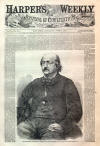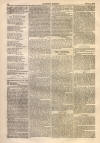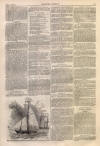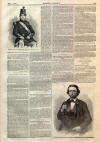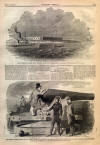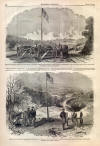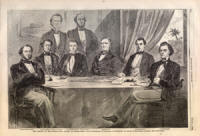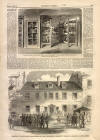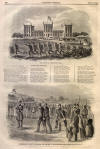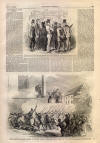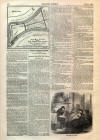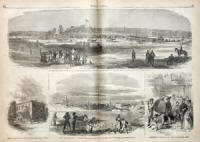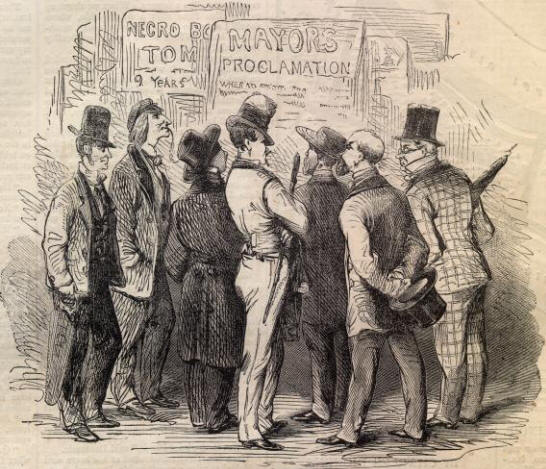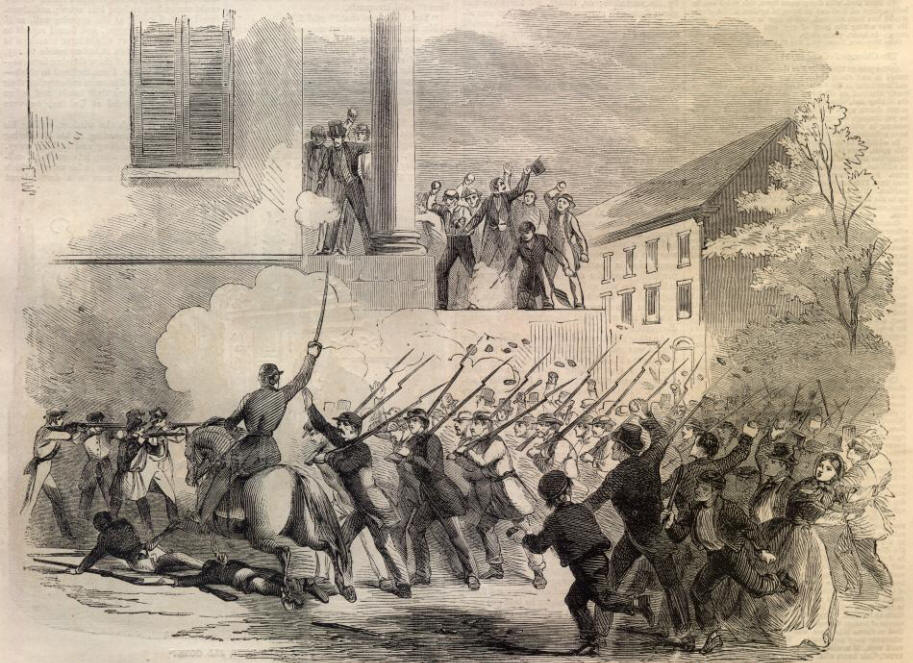|
This Site:
Civil War
Civil War Overview
Civil War 1861
Civil War 1862
Civil War 1863
Civil War 1864
Civil War 1865
Civil War Battles
Confederate Generals
Union Generals
Confederate History
Robert E. Lee
Civil War Medicine
Lincoln Assassination
Slavery
Site Search
Civil War Links
Civil War Art
Revolutionary War
Mexican War
Republic of Texas
Indians
Winslow Homer
Thomas Nast
Mathew Brady
Western Art
Civil War Gifts
Robert E. Lee Portrait
|
THE FIGHT AT SAINT
LOUIS.
WE mentioned in the
last number
of Harper's Weekly that a second encounter had taken place between the troops
and the mob at St. Louis. We now publish two illustrations of the event, from
sketches by Mr. M. Hastings, of St. Louis. The tragedy was thus described by a
spectator :
" About six o'clock (on 11th) a
large body of Home Guards entered the city through Fifth Street from the
Arsenal, where they had been enlisted during the day, and furnished with arms.
On reaching Walnut Street the troops turned westward, a large crowd lining the
pavement to witness their progress. At the corner of Fifth Street parties among
the spectators began hooting, hissing, and otherwise abusing the companies as
they passed, and a boy about fourteen years old discharged a pistol into their
ranks. Part of the rear company immediately turned and fired upon the crowd, and
the whole column was instantly in confusion, breaking their ranks and
discharging their muskets down their own line and among the people on the
sidewalks. The shower of balls for a few minutes was terrible, and bullets
flying in every direction, entering the doors and windows of private residences,
breaking shutters, and smashing bricks in the third story.
" The utmost confusion and
consternation prevailed, spectators fleeing in all directions, and but for the
random firing of the troops scores of people must have been killed. As most of
the firing was directed down their own ranks the troops suffered most severely,
four of their number being instantly killed and several wounded.
" Immense crowds of people filled
the streets after the occurrence. The most intense indignation was expressed
against the Germans. Mayor Taylor
addressed the excited crowd and induced them to disperse under the promise that
no further violence should be done. The city was comparatively quiet during the
evening and night, a heavy rain preventing the assembling of large crowds."
The following account of the
affair is from the St. Louis Republican of May 12 : " Another act in the
terrible drama of blood that opened so fearfully on Friday, was enacted last
evening, and six more victims were added to the already sad list of dead. Two
scenes of blood so close together, and so frightful in their results, have
seldom before plunged a city into mourning. At about half past five o'clock
in the evening a large body of
the German Home Guards entered the city through Fifth Street, from the arsenal,
where they had been enlisted during the day and furnished with arms. Large
crowds collected to witness their march, and they passed unmolested along until
they reached Walnut, when they turned up that street and proceeded westward.
Large crowds were collected on these corners, who hooted and hissed as the
companies passed, and one man standing on the steps of the church fired a
revolver into the ranks. A soldier fell dead, when two more shots were fired
from the windows of a house near by. At this time the head of the column, which
reached as far as Seventh, suddenly
turned, and, leveling their
rifles, fired down the street, and promiscuously among the spectators who lined
the pavement. Shooting as they did directly toward their own rear ranks, they
killed some of their men as well as those composing the crowd. The shower of
bullets was for a moment terrible, and the only wonder is that more lives were
not lost. The missiles of lead entered the windows and perforated the doors of
private residences, tearing the ceilings and throwing splinters in every
direction. The house of Mr. Mathews was entered by three bullets, and Mr.
Mathews's daughter was struck slightly by a spent ball. On the street the scene
presented as the soldiers moved
off was sad indeed. Six men lay
dead at different points, and several were wounded and shrieking with pain upon
the pavements. The dead carts—which have become familiar vehicles since the
scenes of the last two days—were soon engaged in removing the corpses from the
ground. The wounded were carried to the Health Office. Four of the men killed
were members of the regiment, and two were citizens. Last night the former had
not been recognized. Jerry Switzelan, an engineer on the river, was passing by
the door of Mr. H. Glover's residence, on Seventh Street, next to Walnut, when a
ball struck him in the head, and scattered his brains over the door and walls. A
pool of blood marked the spot where he fell, after his body had been removed.
Jeremiah Godfrey, a hired man of Mr. Cozzens, County Surveyor, was working in
the yard of Mr. Cozzens at the time of the occurrence. While stooping over, in
the act of fastening some flowers to a frame, three soldiers entered the gate,
and approaching within the yard, fired three shots into his body. Fortunately,
none of them were fatal, being all flesh wounds. The family witnessed the
affair, and says that the man had not been out of the yard, and was unaware of
the approach of his assailants until stricken down by their bullets. Charles H.
Woodward, a clerk in Pomeroy & Benton's store, was shot in the shoulder, and
will have to have his entire arm amputated. He was carried into the residence of
Mr. Mathews and kindly cared for. James F. Welsh, living at No. 189 Wash Street,
between Fourteenth and Fifteenth streets, was shot through the foot. Michael
Davy, residing between O'Fallen and Cass Avenue and Sixth and Seventh,
received a ball through the
ankle, and amputation will be necessary. John Nelus was wounded in the cheek.
Several others were injured slightly. The houses on the right side of Walnut,
from Fifth to Seventh, were considerably injured by bullets, and the inmates in
several cases had very narrow escapes. At a late hour in the night the bodies of
John Gabnin, whose brother keeps a livery-stable on Market Street, William Cody,
a book-peddler, from
New Orleans, and John Dick, a German soldier, were
recognized among the dead. Immense crowds of people filled the streets after the
occurrence, and the whole city presented a scene of excitement seldom witnessed.
Mayor Taylor made an address to the people from the steps of the church on Fifth
and Walnut streets."
CORNER SCENE DURING THE
EXCITEMENT AT ST. LOUIS, MISSOURI.— [SKETCHED BY M. HASTINGS, Esq.]
UNITED STATES VOLUNTEERS
ATTACKED BY THE MOB, CORNER OF FIFTH AND WALNUT STREETS, ST. LOUIS,
MISSOURI.—[SKETCHED BY M. HASTINGS, ESQ.]
|
